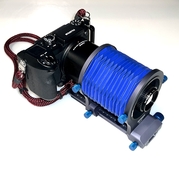JerseyDoug
Member
Good question. I do not know. My personal experience is limited to under-10K solutions and the bottleneck I am seeing is the scanning lens, not sensors. I suppose we can experiment with a 16-shot pixel shifted 150MP sensor but I am not familiar with digital medium format. When I had a Fuji GFX I couldn't find a suitable autofocus macro lens for that platform, that's what led me to PhaseOne. Their sales team started quoting me for the components and I stopped them at the $55K mark (they were not done).
The same enlarging lens with a flat enough field and sufficient resolution to make a good darkroom print can make an equally sharp scan with a digital camera for an inkjet print of the same size. I only scan B&W film. My maximum enlargement ratio for 35mm negatives is 8X. A scan made with my 50/2.8 Schneider Componon-S lens on a 24 megapixel X-trans sensor can produce an 8x10 inkjet print that represents the film grain more clearly than an 8x10 darkroom print I made from the same negative 50+ years ago.


 Remember, the OP said "money is no object", in that case it really doesn't. Absurd resolution, absurd dynamic range, absurd focusing accuracy, absurd price. That's the PhaseOne system. It uses freaking lasers to self-align the focus plane and installation on a concrete slab is highly recommended for perfect stability
Remember, the OP said "money is no object", in that case it really doesn't. Absurd resolution, absurd dynamic range, absurd focusing accuracy, absurd price. That's the PhaseOne system. It uses freaking lasers to self-align the focus plane and installation on a concrete slab is highly recommended for perfect stability 




